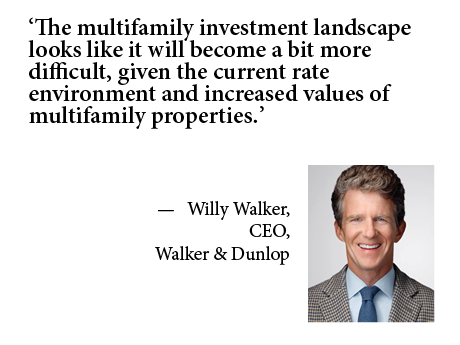By Willy Walker, CEO of Walker & Dunlop
I recently had the pleasure of sitting down to talk with some prominent members of the Walker & Dunlop team, including Kris Mikkelsen, executive vice president of investment sales, Aaron Appel, senior managing director of capital markets, and Ivy Zelman, executive vice president of research and securities. In this episode of the Walker Webcast, “State of CRE,” we covered some of the most prominent issues the commercial real estate industry is facing, as well as some headwinds it will continue to face in the future.
Changes in Homebuilding and Consumer Spending
Although homebuilders had to offer incentives when rates first started increasing last year, they are still seeing a steady demand for homes, as demand still heavily outpaces supply. This imbalance is seen in the new and existing home market. Single-family homes in many markets across the country are in multiple offer situations, indicating that single-family residential real estate is still strong. This is incredible, given the fact that many existing homeowners are locked into mortgage rates in the 2-5 percent range, giving them little reason to move out of their current home.
How Mortgage Deals Are Currently Financed
Although we are experiencing some economically uncertain times, with interest rates rising rapidly and banks collapsing, there is still quite a bit of activity on the mortgage front, especially within Walker & Dunlop. While there has been some tightening in the liquidity pool, we’re not seeing the tightening that the market experienced during the Great Financial Crisis.
Some lenders are certainly pulling back in terms of lending. However, there is still quite a diverse pool of lenders out there willing to finance real estate deals. The lenders offering liquidity now may not offer the most favorable terms or interest rates, but nonetheless, the money is still there for great-quality projects or assets.
Challenges in Office Liquidity
While it’s relatively easy to get financing for any quality investment, there are still widespread difficulties in the office space. Many lenders already have a good bit of office exposure and aren’t looking to add any additional exposure, given the current work-from-home trends that we’ve been seeing. Many believe that work-from-home is here to stay and will create difficulties for commercial office space in the near future.
What to Watch for in the Housing Market
While a widespread Great Financial Crisis-style recession seems unlikely in the near future, that doesn’t mean we won’t see economic uncertainty. We’ll likely see more regional instability, specifically in tech-heavy markets like the Bay Area in California. With tens of thousands of high-paid tech workers being laid off every month, tech-heavy markets will likely see some instability in their housing markets as well as their job markets.
In terms of housing-related stocks, many companies tied to the single-family residential space will likely experience some difficulties in the near-term future. Companies like Rocket Mortgage experienced the highest demand they have ever seen in 2021 and 2022 and likely won’t experience the same volume of demand for years to come. This means there will likely be a stagnation in the stock prices of companies like Rocket in the coming months and potentially even years.
The State of Multifamily
The past decade or so has largely been overwhelmingly easy on the multifamily housing market. However, it looks like the relative ease of investing in multifamily is coming to an end. The multifamily investment landscape looks like it will become a bit more difficult, given the current rate environment and increased values of multifamily properties. Given the fact that deals have become a bit more difficult to finance, well-equipped, savvy investors will continue to thrive in this market — whereas poorly equipped investors will struggle.
Is the Banking Crisis Over?
Given the recent collapses of Silicon Valley Bank, Signature Bank and First Republic Bank, many people are worried that this is just the beginning of a much larger systemic failure of our banking system. However, from what we can tell, that doesn’t look like it’s the case. As of right now, there aren’t any factors that suggest there will be contagion following these collapses. Overall, the economy is faring quite well — inflation is on the decline, and unemployment is still very low. All of these factors, of course, bode well for the consumer.
What Needs to Happen in the Market Now?
Right now, we’re in a situation where if all multifamily projects under construction were to be delivered at the same time, we would be grossly oversupplied with units for rent. This means that we need to see a bit of a pullback in terms of new multifamily construction so that demand can catch back up with supply. Fortunately, given the current interest rate environment, we’re likely to see such a move. Given the fact that debt has become so expensive, many projects simply won’t be viable.
Year-End Predictions
Given that the stock market has rebounded quite a bit from the November 2022 lows we saw just a few months ago, it’s important to look ahead. Currently, the Dow is hovering around the 33,500 mark and the 10-year treasury at the 3.5 percent mark. Although a lot can change over the next 6-7 months, generally speaking, Kris, Aaron and Ivy all agreed that the stock market and bond yields are likely to downtrend over the next few months. However, it’s important to remember that stocks and bonds are much more liquid than real estate, meaning they are much more volatile on a day-to-day basis than real estate. This means, although they expect a downtrend by the end of the year, we may see some wild swings in the meantime.
Walker & Dunlop is a content partner of REBusinessOnline. For more articles from and news about Walker & Dunlop, click here.
Watch the May 10 webcast here.
Learn about upcoming Walker Webcast events here.


